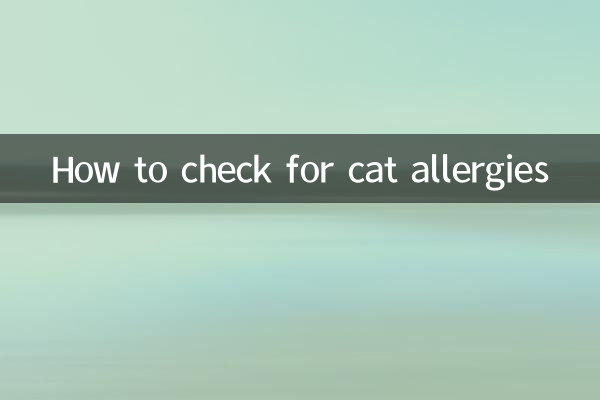How to check for cat allergies
Cat allergies are a concern for many cat owners, especially if their cat exhibits symptoms such as frequent sneezing, itchy skin, or gastrointestinal upset. Knowing how to check for cat allergens can help owners take better care of their pets. The following is a summary of recent hot topics on the Internet about cat allergies, as well as detailed methods on how to detect allergens.
1. Recent hot topics and hot content

According to the Internet search data in the past 10 days, the following are the hot topics and discussion points about cat allergies:
| hot topics | focus of discussion | heat index |
|---|---|---|
| Cat food allergies | Common allergenic foods and alternatives | 85% |
| environmental allergens | Pollen, dust mites, mold | 78% |
| skin allergy symptoms | Itching, redness, swelling, hair loss | 72% |
| Allergy Testing Methods | Blood tests, skin tests | 65% |
2. Common symptoms of cat allergies
There are many symptoms of cat allergies, but here are some common ones:
| Symptom type | Specific performance | possible allergens |
|---|---|---|
| skin symptoms | Itching, redness, swelling, hair loss | fleas, food, detergent |
| respiratory symptoms | sneezing, runny nose | Pollen, dust mites |
| gastrointestinal symptoms | Vomiting, diarrhea | food allergy |
3. How to check for cat allergens
Checking for cat allergens is a step-by-step process of elimination. The following are the specific steps:
1. Observe the time and environment when symptoms appear
Record the time and place where the cat's symptoms appear to help determine whether it is a food allergy or an environmental allergy. For example, if your symptoms worsen during the change of seasons, you may have a pollen allergy.
2. Gradually eliminate food allergies
Food allergy is a common type of allergy in cats and can be checked by the following methods:
| steps | Specific operations |
|---|---|
| single diet | Feed your cat a single protein source and see if symptoms subside |
| Gradually introduce new foods | Introduce a new food every two weeks and watch for allergic reactions |
3. Environmental allergen testing
If you suspect an environmental allergy, you can take the following steps:
| measures | Specific operations |
|---|---|
| clean environment | Clean your home regularly, change bed sheets, and use an air purifier |
| Reduce going out | Reduce cat outings during pollen season to avoid contact with allergens |
4. Professional testing
If the results of self-examination are not obvious, you can take the cat to a veterinary clinic for professional testing:
| Detection method | Applicable situations |
|---|---|
| blood test | Detect IgE antibodies to determine allergens |
| Skin test | Inject allergens subcutaneously and observe skin reactions |
4. Prevention and treatment
Once the allergen is identified, the following steps can be taken to prevent and treat it:
| measures | Specific operations |
|---|---|
| Avoid contact with allergens | Change food and clean environment |
| drug treatment | Use antihistamines or hormones (veterinary guidance required) |
5. Summary
Checking for cat allergens requires patience and careful observation. Combined with the step-by-step elimination method and professional testing, allergens can be found more accurately. Through reasonable prevention and treatment measures, the quality of life of cats can be effectively improved.

check the details

check the details